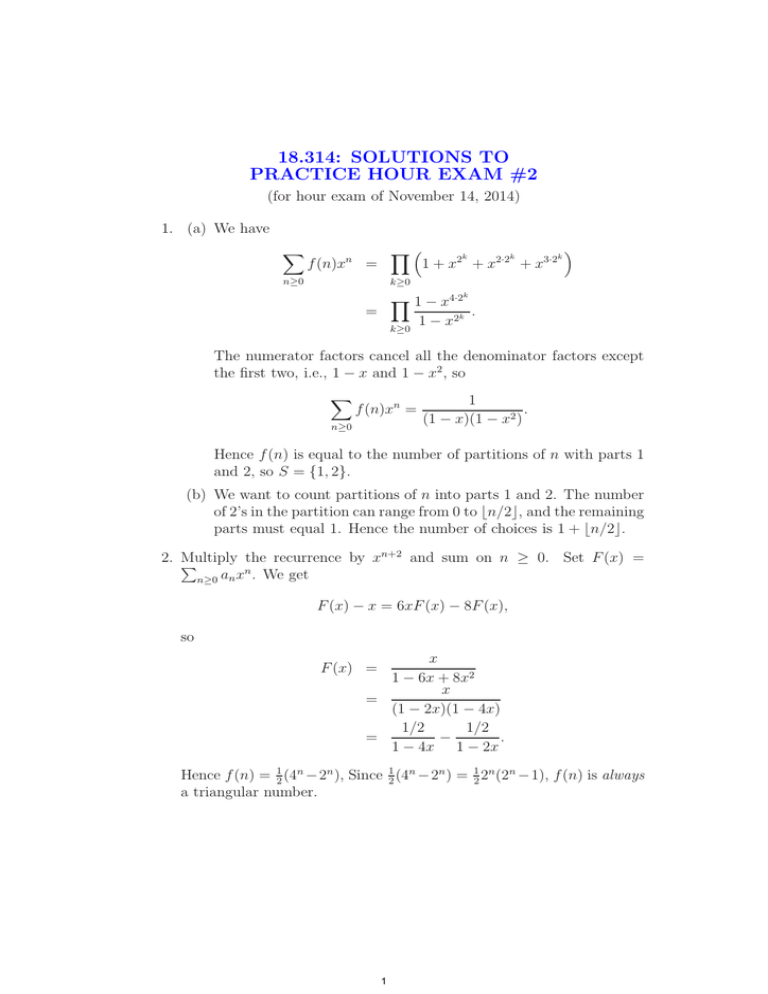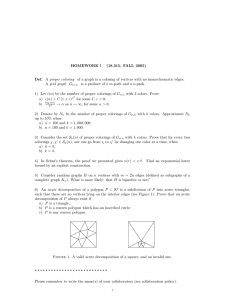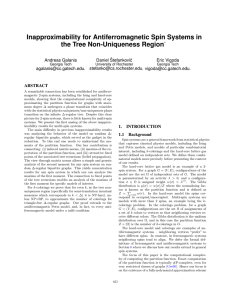18.314: SOLUTIONS TO PRACTICE HOUR EXAM #2
advertisement

18.314: SOLUTIONS TO
PRACTICE HOUR EXAM #2
(for hour exam of November 14, 2014)
1. (a) We have
X
Y
k
k
k
1 + x2 + x2·2 + x3·2
f (n)xn =
n≥0
k≥0
Y 1 − x4·2k
=
k ≥0
1 − x2k
.
The numerator factors cancel all the denominator factors except
the first two, i.e., 1 − x and 1 − x2 , so
X
f (n)xn =
n≥0
1
.
(1 − x)(1 − x2 )
Hence f (n) is equal to the number of partitions of n with parts 1
and 2, so S = {1, 2}.
(b) We want to count partitions of n into parts 1 and 2. The number
of 2’s in the partition can range from 0 to ⌊n/2⌋, and the remaining
parts must equal 1. Hence the number of choices is 1 + ⌊n/2⌋.
2. Multiply
the recurrence by xn+2 and sum on n ≥ 0. Set F (x) =
P
n
n≥0 an x . We get
F (x) − x = 6xF (x) − 8F (x),
so
x
1 − 6x + 8x2
x
=
(1 − 2x)(1 − 4x)
1/2
1/2
=
−
.
1 − 4x 1 − 2x
F (x) =
Hence f (n) = 12 (4n −2n ), Since 21 (4n −2n ) = 12 2n (2n −1), f (n) is always
a triangular number.
1
3. We are choosing an ordered pair (S, T ) of subsets of the pencils such
that #S is odd and then coloring each pencil in S either red, blue,
green, or yellow, and coloring each pencil in T either white, black, or
Halayà úbe. If S has k elements where k is odd, then the number of
colorings of S is 4k . If T has k elements then the number of colorings
of T is 3k . The exponential generating function for the number of
colorings of S is
F (x) =
X
k odd
4k
xk
k!
= sinh(4x)
1 4x
=
(e − e−4x ).
2
The exponential generating function for the number of colorings of T
is
X xk
G(x) =
3k
= e3x .
k!
k≥0
Hence by Theorem 8.21 on page 168, we have
X
1 4x
xn
=
(e − e−4x )e3x
f (n)
n!
2
n≥0
1 7x
(e − e−x )
2
1X n
xn
=
(7 − (−1)n ) ,
2 n≥0
n!
=
so f (n) = 12 (7n − (−1)n ).
Note. Halayà ubé is a kind of purple color named after a Phillipines
dessert made from boiled and grated purple yams. See
http://en.wikipedia.org/wiki/List of colors.
4. (a) Each Hamiltonian path has n − 1 edges. The total number of
edges of Kn is n2 = n(n − 1)/2. Hence the number of paths is
n/2, which fails to be an integer when n is odd.
(b) Let the vertices be 0, 1, . . . , n − 1. Let one of the paths P have
vertices (in their order along P )
n
0, n − 1, 1, n − 2, 2, n − 3, . . . , .
2
2
Let the other paths be obtained from P by adding i to each coordinate for i = 1, 2, . . . , n2 − 1, and taking the sum modulo n (i.e.,
if the sum exceeds n − 1 then subtract n from it). For instance, if
n = 8 then the four paths are
0
1
2
3
7
0
1
2
1
2
3
4
6
7
0
1
2
3
4
5
5
6
7
0
3
4
5
6
4
5
6
7.
We leave the verification that this works as an exercise.
Another way to describe the same solution (suggested by Y. Hu) is
to put the vertices 0, 1, . . . , n−1 in clockwise order on a circle. Let
P be the zigzag path whose vertices (in order) are 0, n − 1, 1, n −
2, 2, n − 3, 3, . . . , 12 n. Rotate the circle around the center by 2jπ/n
radians for 0 ≤ j ≤ n2 − 1. Each such rotation gives one of the
paths in the partition into Hamiltonian paths.
3
MIT OpenCourseWare
http://ocw.mit.edu
18.314 Combinatorial Analysis
Fall 2014
For information about citing these materials or our Terms of Use, visit: http://ocw.mit.edu/terms.

